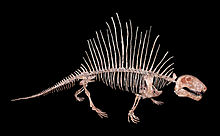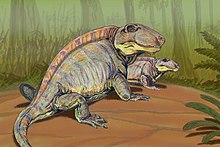Sphenacodontidae
| Sphenacodontidae | |
|---|---|

| |
Dimetrodon limbatus skeleton
| |
| Scientific classification | |
| Domain: | Eukaryota |
| Kingdom: | Animalia |
| Phylum: | Chordata |
| Clade: | Synapsida |
| Clade: | Sphenacodontoidea |
| Family: | †Sphenacodontidae Marsh, 1878 |
| Genera & clades | |
| |
Sphenacodontidae (Greek: "wedge point tooth family") is an
Late Pennsylvanian to middle Permian "pelycosaurs". The most recent one, Dimetrodon angelensis, is from the latest Kungurian or, more likely, early Roadian San Angelo Formation.[1][2] However, given the notorious incompleteness of the fossil record, a recent study concluded that the Sphenacodontidae may have become extinct as recently as the early Capitanian.[3] Primitive forms were generally small (60 cm to 1 meter), but during the later part of the early Permian these animals grew progressively larger (up to 3 meters or more), to become the top predators of terrestrial environments.[4] Sphenacodontid fossils are so far known only from North America and Europe
.
Characteristics

The skull is long, deep and narrow, an adaptation for strong jaw muscles. The front teeth are large and dagger-like, whereas the teeth in the sides and rear of the jaw are much smaller (hence the name of the well-known genus Dimetrodon – "two-measure tooth", although all members of the family have this attribute).
Several large (~3 meters) and advanced members of this group (geographically isolated group should evolve a sail, but the other group not.
Classification
Cutleria
The
monophyletic group that includes sphenacodontids and all their descendants (including mammals), while Sphenacodontidae in the strict sense includes only specialised pelycosaurs, and not earlier more primitive members of the family like Haptodus, Palaeohatteria, Pantelosaurus, and Cutleria (in pre-cladistic classifications all included under the genus Haptodus). The clade Sphenacodontoidea is used by Laurin and Reisz 1997 to designate the most recent common ancestor of Sphenacodontidae and Therapsida
and all their descendants, and is defined by certain features of the skull.
Sphenacodontidae in a cladogram after Fröbisch et al., 2011:[4]
| |||||||||||||||||||||||||||||||||||||||||||||||||
See also
References
Further reading
- Carroll, R. L. (1988), Vertebrate Paleontology and Evolution, WH Freeman & Co.
- Colbert, E. H., (1969), Evolution of the Vertebrates, John Wiley & Sons Inc (2nd ed.)
- Laurin, M. and Reisz, R. R., 1997, Autapomorphies of the main clades of synapsids
- ISBN 3-89937-032-5
- Romer, A. S., (1947, revised ed. 1966) Vertebrate Paleontology, University of Chicago Press, Chicago
- Romer, A. S. and Price, L. I., (1940), Review of the Pelycosauria, Geological Society of America Special Papers, No 28
